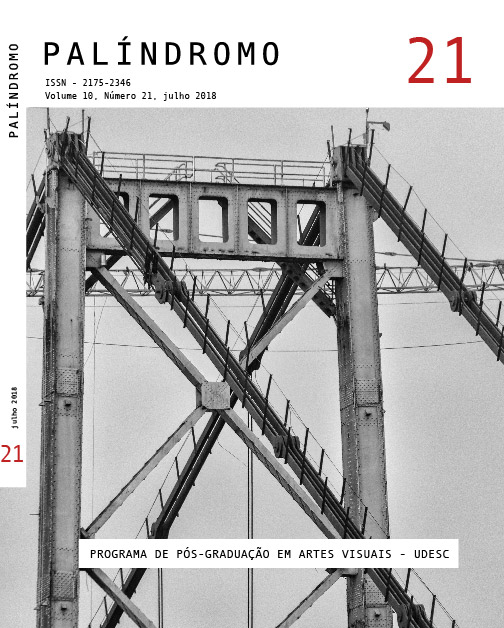IDENTITY RUPTURES IN THE ARTISTIC PRODUCTION OF CINDY SHERMAN AND YASUMASA MORIMURA
DOI:
https://doi.org/10.5965/2175234610212018116Keywords:
Cindy Sherman, Yasumasa Morimura, identities, queer approachAbstract
This article proposes a queer analysis of the artistic productions of Cindy Sherman and Yasumasa Morimura with the intent of question the lack of existence of a single and original individual in the contemporary society. The queer perspective allows to deconstruct a fix identity concept, providing a plural inter-pretation of art. Sherman and Morimura present themselves as changeable individuals with ephemeral identities in order to unstable the conventional gender identification system. Their productions are based on the process of an ever changing identity, to (de)construct themselves constantly. Throughout Sherman productions, the self-portrait language is analysed, questioning in what way can the self-portrait expose an individual in contemporary art. The individual is discussed in Morimura’s work through the camp aesthetics, combined with the concepts of exaggeration and imitation, questioning the permanency of an identity and the natural processes in the construction of an individual.
Downloads
References
ANZALDÚA, G. Borderlands/La Frontera. San Francisco: Aunt Lute Books, 1987.
ARCHER, M. Arte contemporânea: uma história concisa. São Paulo: Martins Fontes, 2012.
ALTHUSSER, L. Ideología y aparatos ideológicos del estado. Buenos Aires: Nueva Visión, 1988.
BALIEIRO, F. F. Carmen Miranda entre os desejos de duas nações: cultura de massas, performatividade e cumplicidade subversiva em sua trajetória. UFSCar: Tese de Doutorado, 2014.
BAUMAN, Z. Ensaios sobre o conceito de cultura. Rio de Janeiro: Jorge Zahar Editor, 2012.
BLANCA, R. M. Arte a partir de uma perspectiva queer. UFSC: tese de douto-rado, 2011.
BOURCIER, MH S. Queer Zones 3: identités, cultures et politiques. Paris: Édi-tions Amsterdam, 2011.
BUTLER, J. Problemas de gênero: feminismos e subversão da identidade. Rio de Janeiro: Civilização Brasileira, 2016.
DEMPSEY, A. Estilos Escolas e Movimentos. São Paulo: Cosac Naify, 2010.
FABRIS, A. Cindy Sherman ou de alguns estereótipos cinematográficos e televi-sivos. Revista Estudos Feministas, Florianópolis , v. 11, n. 1, p. 61-70, 2003.
FABRIS, Annateresa. Uma” magnífica presa”: representações visuais de Marilyn Monroe. Anais do Museu Paulista: História e Cultura Material, v. 23, n. 1, p. 11-28, 2015.
FOUCAULT, M. Surveiller et punir. Paris: Gallimard, 1975.
FOUCAULT, M. O que é um autor? Lisboa: Passagens, 1992.
FOUCAULT, M. Microfísica do poder. São Paulo: Paz e Terra, 2016.
HALL, S. A identidade cultural na pós-modernidade. Rio de Janeiro: Lampa-rina, 2015.
JONES, A. Tracing the Subject with Cindy Sherman. In: CRUZ, Amada et al. Cindy Sherman. London: Thames and Hudson, 1997.
LOURO, G. L. Um corpo estranho: ensaios sobre sexualidade e teoria queer. Belo Horizonte: Autêntica, 2004.
MISKOLCI, R. Teoria Queer: um aprendizado pelas diferenças. Belo Horizonte: Autêntica, 2012.
ORWELL, G. 1984. 17. ed. São Paulo: Nacional, 1984.
PACHECO, M. E. V. A pintura do autorretrato contemporâneo em Portugal: breve panorâmica. Diacrítica, Braga, v. 26, n. 3, p. 93-130, 2012.
PELÚCIO, Larissa. Breve história afetiva de uma teoria deslocada. Florestan, v. 1, p. 26-45, 2014.
PRECIADO, P. B. Género y performance: 3 episodios de un cybermanga femi-nista queer trans. Debate feminista, v. 40, p. 111-123, 2009.
RODRÍGUEZ, J. M. Queer Latinidad: Identity practices, discursive spaces.New York: New York University Press, 2003.
RUBIN, G. Reflexionando sobre el sexo: notas para una teoria radical de la sexu-alidad. In: VANCE, C. Placer y peligro. Explorando la sexualidade femenina. Madrid: Ed. Revolución, 1989.
SONTAG, S. Notas sobre o Camp. In: Contra a interpretação. Porto Alegre: LPM, 1987.
SOUZA, R. O que o camp tem a nos dizer em 2014. In: Anais do 23º Encontro da ANPAP, 2014.
TADEU, T. Nós ciborgues: o corpo elétrico e a dissolução do humano. In: HARAWAY, D; KUNZRU, H; TADEU, T. A antropologia do ciborgue: as vertigens do pós-humano. Belo Horizonte: Autêntica, 2016.
Downloads
Published
How to Cite
Issue
Section
License
Copyright (c) 2018 Palíndromo

This work is licensed under a Creative Commons Attribution 4.0 International License.
COPYRIGHT STATEMENT
The articles published by the magazine are free to use, intended for academic and non-commercial applications. Copyright is all assigned to the magazine. The articles whose authors are identified represent the expression from the point of view of their authors and not the official position of Palíndromo Magazine. The author (s) commits to whenever they publish material referring to the article published in Palíndromo mention this publication as follows:
This article was originally published by Palíndromo magazine in its volume (place the volume), number (place the number) in the year of (place the year) and can be accessed at: http://www.revistas.udesc.br/index.php/palindromo


